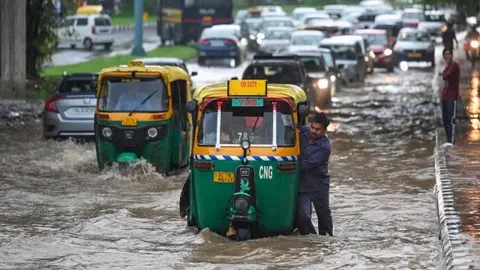Flood warning in Delhi as rains batter north India
 Getty Images
Getty ImagesHeavy rains are continuing to cause havoc across northern India, claiming at least 20 lives since Saturday.
The bad weather - which is expected to continue into Friday - has downed trees, flooded homes and closed major roads in several states.
On Tuesday, Delhi was put on high alert for flooding as water levels in the Yamuna river rose to dangerous levels.
Officials have since relocated thousands of people living near the river banks to safer locations.
Residents living in other vulnerable areas have also been told to prepare to be evacuated if needed.
Traffic over a key bridge, which runs over the river, was cut off and schools are closed for a second day due to heavy rainfall.
Delhi's Chief Minister Arvind Kejriwal said the next two days would be crucial for the city, but added that his government was prepared to tackle any situation.
India's weather department has warned that heavy rains are expected to continue in the region well into the weekend.
In the Himalayan states of Himachal Pradesh and Uttarakhand, teams of the Indian army and the National Disaster Response Force have been carrying out rescue operations after landslides and flash floods damaged roads and buildings.
In Himachal Pradesh, over 700 roads and key highways have been closed due to landslides.
Massive waterlogging was also reported in the states of Rajasthan, Punjab and Haryana.
 Getty Images
Getty ImagesVisuals showed people wading through flooded streets while vehicles lay submerged under water.
The Amarnath Yatra - an annual Hindu pilgrimage to a Himalayan cave shrine in Indian-administered Kashmir - has also been suspended for the fourth consecutive day after a national highway was damaged, leaving thousands of pilgrims stranded in nearby areas.
Seasonal monsoon rains, which last from June to September, are a lifeline for India but typically also cause deaths and destruction to property every year.
India has experienced increasingly extreme weather in recent years - the unrelenting rains come just weeks after an extreme heat wave gripped most of north India.
Many factors contribute to flooding, but experts say climate change caused by global warming makes extreme rainfall more likely.
BBC News India is now on YouTube. Click here to subscribe and watch our documentaries, explainers and features.

Read more India stories from the BBC:

